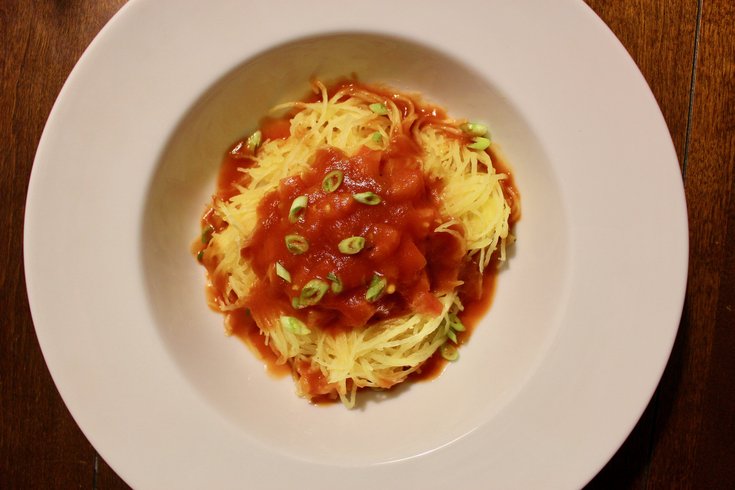
May 01, 2018
 Tom D'Intino/for PhillyVoice
Tom D'Intino/for PhillyVoice
Spaghetti Squash with Chunky Tomato Sauce
Over the course of several centuries, pasta has morphed from a traditional Italian staple to a versatile food found in kitchens and restaurants everywhere. While pasta was once reserved for wealthy elites, it has become an affordable addition to many pantries. From linguine to ravioli to tortellini, this complex carbohydrate takes on many shapes, and can be stuffed, baked, boiled, sauced, or added to an array of soups and casseroles.
Although pasta is a palate-pleaser for many diners, it is low in overall nutrients and high in refined and processed ingredients, like durum wheat flour. In addition to lacking key vitamins and minerals, pasta can also be hard for the system to digest. Suffers of Celiac disease know the negative effects of gluten all too well, and the availability of gluten-free foods is evidence of a growing need for alternative options to traditional wheat products.
Despite pasta’s bad rap, there are ways to indulge in your favorite noodle dishes without sacrificing your health.
Swapping white, unenriched pasta for whole grain varieties will help you reap the nutritional benefits from your next bowl of spaghetti. Whole grain food products are less processed, meaning each component of the grain, from the bran to the germ, remain intact. This means that whole grain pastas contain more fiber and protein, as well as a host of other key nutrients like calcium, iron, and B vitamins.
The only potential pitfall, however, is a slight difference in taste — whole grain pasta has a nutty flavor and a somewhat grainy texture, which may take some time to get used to. Ease into this new noodle variety with the help of a healthy, savory sauce.
Vegetables make great substitutes for the carb-heavy pasta we’re accustomed to consuming. The nutritional gains are abundantly clear: vegetables are packed full of vitamins and are completely gluten-free. But before you reach for your spiralizer, you should know that not all veggies are created equal, and some are better suited for this technique than others.
Zucchini is the reigning champ of spiralized veggies; its long shape and firm texture make it the ideal replacement for noodles. Many root vegetables can be used as well, including carrots, turnips, and parsnips. Because vegetables contain a lot of water, pair your veggie noodles with thicker sauces, like a hearty avocado kale pesto, to give the dish substance and flavor.
Pasta made from beans and legumes contains the highest amount of fiber, which will help keep you feeling fuller, longer. Ingredients like chickpeas, lentils, and black beans pack major protein power, and are even better for you than other gluten-free options with a brown rice or corn base. Even after cooking, beans retain their starch, which helps to slow digestion and lower your glycemic index. Resistant starches also increase nutrient circulation, impede bacterial growth, and keep your colon and digestive tract healthy.
Soba noodles, also known as buckwheat noodles, originated in Japan and are frequently eaten cold. This variety is lower in both carbs and calories than traditional pasta. By making the switch from regular white pasta to soba noodles, you can decrease your calorie intake by half. When you’re shopping for soba noodles, make sure to look for the “100% buckwheat” label on the box; a buckwheat blend won’t offer the same healthful benefits as the real thing.
With a diverse selection of alternatives lining grocery store shelves, making the switch from traditional pasta to more wholesome versions couldn’t be easier. Even if you prefer to stick with regular wheat pasta, studies show that it won’t adversely affect your health when consumed in modest quantities. Maintaining healthy portion control is important regardless of your pasta preference, so be sure to remain mindful of both quality and quantity when indulging in your favorite noodle-based dish.